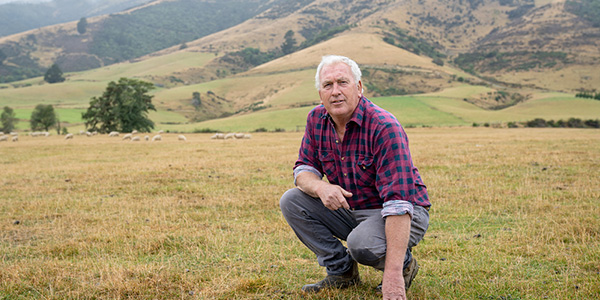Despite rain this week, West Otago farmer Bruce Murray is dealing with his fifth successive dry summer. Photo: Natwick.
A four-month dry spell in Southland and parts of Otago is making this summer the toughest in memory for many farmers, compounded by a lack of access to meatworks and a shortage of supplementary feed.
Coastal Southland is the driest since Environment Southland started keeping records 50 years ago, with most areas recording just 60% of the normal rainfall from December through until the end of February.
Dry conditions are spreading north into the rest of Southland, South Otago and West Otago.
Total rainfall in normally summer reliable Southland from October till now at one site is 300mm below normal, with just 2mm falling so far in March.
Dairy farmers are drying-off cows early and the feed shortage is being exacerbated by farmers waiting weeks to get access for prime stock at meatworks and meant stock has been sent to grazing.
Data shows Southland pasture growth in recent weeks has fallen to close to mid-winter levels.
Otautau dairy farmer Edwin Mabonga said milk production is 8% below last year and 13% below his target for this season.
“We’ve stopped looking at that,” Mabonga said.
Fellow dairy farmer Jon Pemberton said grass production for the year will be three tonnes less than normal.
Conditions have been tough since spring, which was cold and wet.
November was favourable, but grass growth slowed in December and hasn’t recovered.
“For Southland it’s unreal. It’s pretty dire,” Pemberton said.
High product prices have been a saviour.
“If we had a $7/kg MS payout and $100 lambs, I don’t know how we would go,” he said.
Wyndham farmer Dean Rabbidge has had killing space cancelled on several occasions, leaving him with 1300 lambs left to kill.
“Normally it would be okay if we had space at meatworks,” Rabbidge said of the dry conditions.
“That’s been a kick in the guts, the inability to move stock.”
Meat companies have been battling to maintain processing capacity while coping with staff infected with covid or required to isolate because family members have the virus.
Rabbidge said the dry weather means he is unable to apply fertiliser so has turned his focus to next season, aiming to only have capital stock by the end of the month and will put the ram out early.
Mobanga said he is drying-off 10% of his dairy herd and culling a further 5% to try and extend the season.
With winter crops suffering, he said supplementary feed is either very expensive or in short supply.
He said soil moisture on his farm is 21%, well below the normal levels at this time of the year of 47%. To restore level would require 45mm of rain.
PKE has in recent weeks hit $600 a tonne, up from $250/t, while baleage has risen from $70 a bale to $120, but is in short supply.
There are reports some farmers are ignoring Fonterra’s restrictions on using PKE, saying they need the option given the shortage of alternative feed.
A Fonterra spokesperson said the co-op is closely monitoring the situation and acknowledges PKE is a feed option during adverse weather events.
“When carefully managed, farmers can use it and produce the required milk fat composition,” the spokesperson said.
It will be analysing milk composition for higher fat composition, which can impact quality.
Silver Fern Farms chief executive Simon Limmer reports in a newsletter to suppliers that the worst disruption appears over for its North Island plants, but is now impacting those in the South Island.
“Omicron is currently having the largest impact on our South Island communities, which is particularly impacting capacity at our large Finegand site in Balclutha,” Limmer said.
“Our other South Island sheep and beef plants should be getting closer to normal by the end of next week.”
West Otago farmer Bruce Murray said conditions were dry through summer but have worsened in the last two weeks as substantial rain misses large areas of the southern region.
Rain this week was helpful but not enough to reverse dry conditions
“You could chase a mouse across the place,” Murray said of his Tapanui farm.
He said West Otago is normally weather reliable but this is the fifth successive year he has had to sell lambs as store.
Environment Southland integration manager Nick Perham says NIWA’s climate outlook for March to May indicates temperatures are likely to be above average (65% chance).
However, rainfall is expected to be near normal (40% chance) or above normal (35% chance), which would further help the situation.










